Thermal Performance and Energy Conservation Effect of Grain Bin Walls Incorporating PCM in Different Ecological Areas of China
Abstract
1. Introduction
2. Methodology
2.1. Physical Model
2.2. Governing Equations and Boundary Conditions
- (1)
- A one-dimensional heat transfer was assumed.
- (2)
- The PCM layer was a pure, homogeneous, and isotropic material.
- (3)
- The thermal contract resistance between the PCM layer and concrete layer was negligible.
- (4)
- The surrounding radiations except solar were ignored.
- (5)
- Heat generation, radiation heat transfer, and natural convection in materials were not considered.
- (6)
- The top and bottom boundary of the wall were assumed in adiabatic conditions.
2.3. The Validation and Mesh Independence of Physical Model


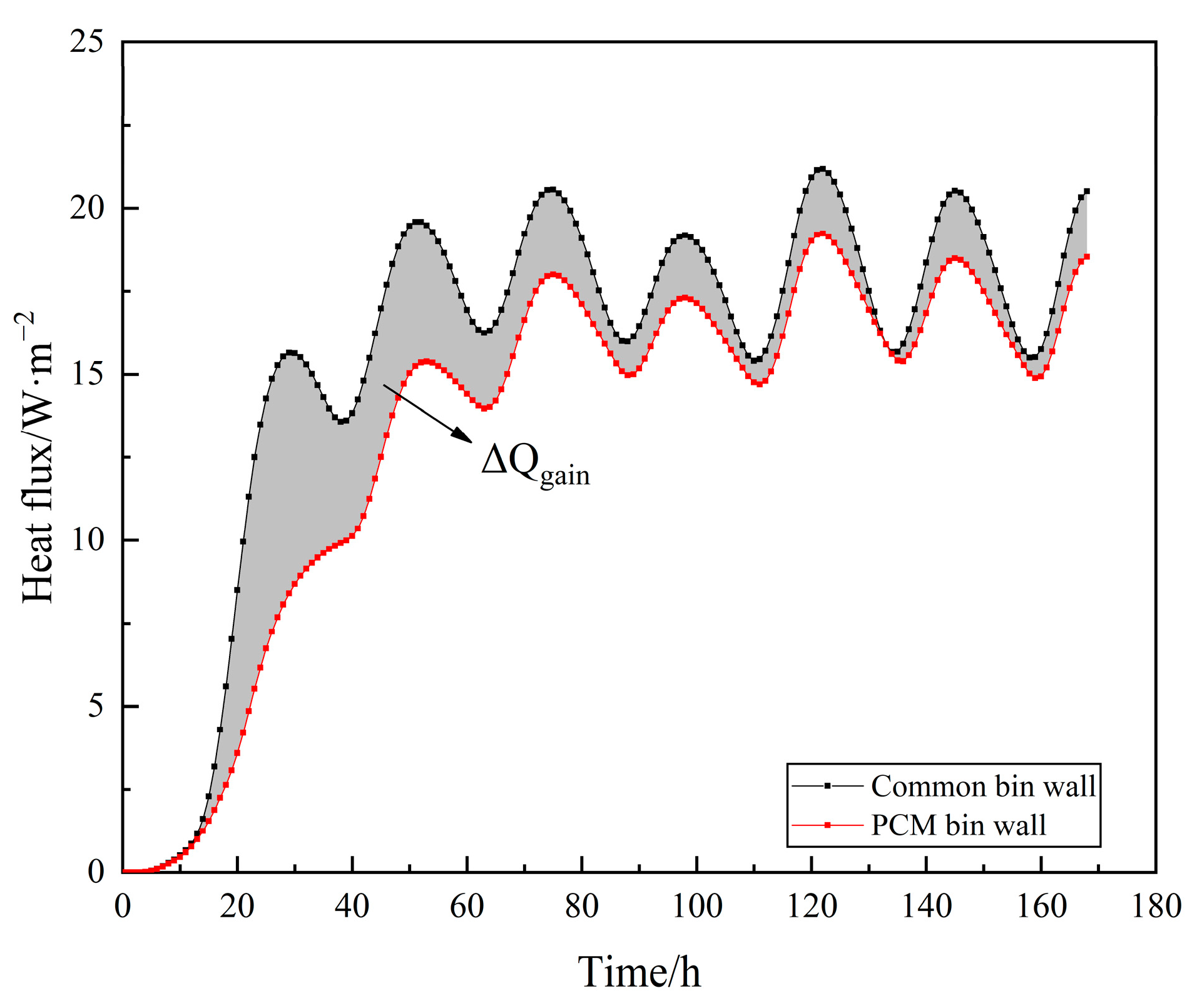
3. Results
3.1. Effects of Latent Heat of PCM
3.1.1. Effects of Latent Heat on Tin and Heat Flux of the Bin Wall
3.1.2. Effects of Latent Heat on Heat Gain of the Bin Wall
3.2. Effects of Phase Change Temperature of PCM
3.2.1. Effect of Phase Change Temperature on Tin
3.2.2. Effect of Tm on the Heat Flux
3.2.3. Effect of Tm on Energy Saving
4. Analysis and Discussion
5. Conclusions
- (1)
- The latent heat of the PCM is vital to its heat storage capacity to maximally regulate the indoor temperature of the grain bin. The cumulative heat gain presents an uptrend with the rise in latent heat. By contrast, a downtrend is observed for the heat gain increment. The selection of latent heat of the PCM should consider the effective utilization rate of the PCM, rather than the direct selection of high PCM latent heat. The maximum utilization rate of latent heat might appear when the latent heat falls within 180 to 250 kJ/kg.
- (2)
- The optimal phase change temperature is highly dependent on the climate conditions. The hot solar-air temperature directly requires a higher phase change temperature of the PCM. Proper phase change temperatures are selected by 31 °C, 28 °C, and 28 °C in Guangzhou, Zhengzhou, and Harbin city, respectively.
- (3)
- The energy saving of the PCM bin wall mainly depends on the phase change temperature and latent heat of the PCM. Based on the above investigation, the energy saving of the PCM bin wall can attain 12.5%, 14.8%, and 17.5%, corresponding with the optimal phase change temperature in Guangzhou, Zhengzhou, and Harbin.
Author Contributions
Funding
Data Availability Statement
Conflicts of Interest
References
- Bhamare, D.K.; Rathod, M.K.; Banerjee, J. Numerical model for evaluating thermal performance of residential building roof integrated with inclined phase change material (PCM) layer. J. Build. Eng. 2020, 28, 101018. [Google Scholar] [CrossRef]
- Yan, T.; Sun, Z.W.; Gao, J.J.; Xu, X.H.; Yu, J.J.; Gang, W.J. Simulation study of a pipe-encapsulated PCM wall system with self-activated heat removal by nocturnal sky radiation. Renew. Energy 2019, 146, 1451–1464. [Google Scholar] [CrossRef]
- Fard, P.M.; Alkhansari, M.G. Innovative fire and water insulation foam using recycled plastic bags and expanded polystyrene (EPS). Constr. Build. Mater. 2011, 305, 124785. [Google Scholar] [CrossRef]
- Priyanka, E.; Dhanya, S.; Mini, K.M. Functional and strength characteristics of EPS beads incorporated foam concrete wall panels. Mater. Today: Proc. 2021, 46, 5167–5170. [Google Scholar] [CrossRef]
- Duan, S.P.; Wang, L.; Zhao, Z.Q.; Zhang, C.W. Experimental study on thermal performance of an integrated PCM Trombe wall. Renew. Energy 2021, 163, 1932–1941. [Google Scholar] [CrossRef]
- Al-Yasiri, Q.; Szabó, M. Incorporation of phase change materials into building envelope for thermal comfort and energy saving: A comprehensive analysis. J. Build. Eng. 2021, 36, 102122. [Google Scholar] [CrossRef]
- Yang, W.B.; Sun, T.F.; Yang, B.B.; Wang, F. Laboratory study on the thermo-mechanical behaviour of a phase change concrete energy pile in summer mode. J. Energy Storage 2021, 41, 102875. [Google Scholar] [CrossRef]
- Mousa, M.M.; Bayomy, A.M.; Saghir, M.Z. Phase change materials effect on the thermal radius and energy storage capacity of energy piles: Experimental and numerical study. Int. J. Thermofluids. 2021, 10, 100094. [Google Scholar] [CrossRef]
- Mahedi, M.; Cetin, B.; Cetin, K.S. Freeze-thaw performance of phase change material (PCM) incorporated pavement subgrade soil. Constr. Build. Mater. 2019, 202, 449–464. [Google Scholar] [CrossRef]
- Ryms, M.; Denda, H.; Jaskuła, P. Thermal stabilization and permanent deformation resistance of LWA/PCM-modified asphalt road surfaces. Constr. Build. Mater. 2017, 142, 328–341. [Google Scholar] [CrossRef]
- Kishore, R.A.; Bianchi, M.V.A.; Booten, C.; Vidal, J.; Jackson, R. Enhancing building energy performance by effectively using phase change material and dynamic insulation in walls. Appl. Energy 2021, 283, 116306. [Google Scholar] [CrossRef]
- Sharma, V.; Rai, A.C. Performance assessment of residential building envelopes enhanced with phase change materials. Energ. Build. 2020, 208, 109664. [Google Scholar] [CrossRef]
- Cabeza, L.F.; Navarro, L.; Pisello, A.L.; Olivieri, L.; Bartolomé, C.; Sánchez, J.; Álvarez, S.; Álvarez, J.S. Behaviour of a concrete wall containing micro-encapsulated PCM after a decade of its construction. Sol. Energy 2020, 200, 108–113. [Google Scholar] [CrossRef]
- Lamrani, B.; Johannes, K.; Kuznik, F. Phase change materials integrated into building walls: An updated review. Renew. Sustain. Energy Rev. 2021, 140, 110751. [Google Scholar] [CrossRef]
- Lee, K.O.; Medina, M.A.; Sun, X.Q.; Jin, X. Thermal performance of phase change materials (PCM)-enhanced cellulose insulation in passive solar residential building walls. Sol. Energy 2018, 163, 113–121. [Google Scholar] [CrossRef]
- Liu, Z.Q.; Huang, J.H.; Cao, M.; Jiang, G.W.; Yan, Q.H.; Hu, J. Experimental study on the thermal management of batteries based on the coupling of composite phase change materials and liquid cooling. Appl. Therm. Eng. 2021, 185, 116415. [Google Scholar] [CrossRef]
- Torres-Rodríguez, A.; Morillón-Gálvez, D.; Aldama-Ávalos, D.; Hernández-Gómez, V.H.; Kerdan, I.G. Thermal performance evaluation of a passive building wall with CO2-filled transparent thermal insulation and paraffin-based PCM. Sol. Energy 2020, 205, 1–11. [Google Scholar] [CrossRef]
- Qu, Y.; Wang, S.; Tian, Y.; Zhou, D. Comprehensive evaluation of Paraffin-HDPE shape stabilized PCM with hybrid carbon nano-additives. Appl. Therm. Eng. 2019, 163, 114404. [Google Scholar] [CrossRef]
- Tunçbilek, E.; Arıcı, M.; Krajčík, M.; Nižetić, S.; Karabay, H. Thermal performance based optimization of an office wall containing PCM under intermittent cooling operation. Appl. Therm. Eng. 2020, 179, 115750. [Google Scholar] [CrossRef]
- Bhamare, D.K.; Rathod, M.K.; Banerjee, J. Proposal of a unique index for selection of optimum phase change material for effective thermal performance of a building envelope. Sol. Energy 2021, 218, 129–141. [Google Scholar] [CrossRef]
- Kishore, R.A.; Bianchi, M.V.A.; Booten, C.; Vidal, J.; Jackson, R. Parametric and sensitivity analysis of a PCM-integrated wall for optimal thermal load modulation in lightweight buildings. Appl. Therm. Eng. 2021, 187, 116568. [Google Scholar] [CrossRef]
- Kishore, R.A.; Bianchi, M.V.A.; Booten, C.; Vidal, J.; Jackson, R. Optimizing PCM-integrated walls for potential energy savings in U.S. Buildings. Energ. Build. 2020, 226, 110335. [Google Scholar] [CrossRef]
- Li, Z.X.; Al-Rashed, A.A.A.A.; Rostamzadeh, M.; Kalbasi, R.; Shahsavar, A.; Afrand, M. Heat transfer reduction in buildings by embedding phase change material in multi-layer walls: Effects of repositioning, thermophysical properties and thickness of PCM. Energy Convers. Manag. 2019, 195, 43–56. [Google Scholar] [CrossRef]
- Pirasaci, T. Investigation of phase state and heat storage form of the phase change material (PCM) layer integrated into the exterior walls of the residential-apartment during heating season. Energy 2020, 207, 118176. [Google Scholar] [CrossRef]
- Yuan, X.S.; Wang, B.M.; Chen, P.; Luo, T. Study on the frost resistance of concrete modified with steel balls containing phase change material (PCM). Materials 2021, 14, 4497. [Google Scholar] [CrossRef] [PubMed]
- Tian, Y.; Lai, Y.M.; Pei, W.S.; Qin, Z.P.; Li, H.W. Study on the physical mechanical properties and freeze-thaw resistance of artificial phase change aggregates. Constr. Build. Mater. 2022, 329, 127225. [Google Scholar] [CrossRef]
- Lqbal, S.; Tang, J.W.; Raza, G.; Cheema, I.I.; Kazmi, M.A.; Li, Z.R.; Wang, B.M.; Liu, Y. Experimental and numerical analyses of thermal storage tile-bricks for efficient thermal management of buildings. Buildings 2021, 11, 357. [Google Scholar]
- Al-Yasiri, Q.; Szabó, M. Case study on the optimal thickness of phase change material incorporated composite roof under hot climate conditions. Case Stud. Constr. Mater. 2021, 14, e00522. [Google Scholar] [CrossRef]
- Yang, W.Q.; Li, X.H.; Liu, X.; Zhang, Y.B.; Gao, K.; Lv, J.H. Improvement of soybean quality by ground source heat pump (GSHP) cooling system. J. Stored Prod. Res. 2015, 64, 113–119. [Google Scholar] [CrossRef]
- Li, X.J.; Han, Z.Q.; Lin, Q.; Wu, Z.D.; Chen, L.; Zhang, Q. Smart cooling-aeration guided by aeration window model for paddy stored in concrete silos in a depot of Guangzhou, China. Comput. Electron. Agr. 2020, 173, 105452. [Google Scholar] [CrossRef]
- GB/T29890-2013, Technical Criterion for Grain and Oil-Seeds Storage; China Standards Press: Beijing, China, 2013.
- Yan, Q.S.; Zhao, Q.Z. Building Thermal Process; China Architecture & Building Press: Beijing, China, 1986; pp. 86–88. [Google Scholar]
- Qiu, L.; Ouyang, Y.X.; Feng, Y.H.; Zhang, X.X. Review on micro/nano phase change materials for solar thermal applications. Renew. Energy 2019, 140, 513–538. [Google Scholar] [CrossRef]
- Lawag, R.A.; Ali, H.M. Phase change materials for thermal management and energy storage: A review. J. Energy Storage 2022, 55, 105602. [Google Scholar] [CrossRef]
- Qu, J.Y. The Construction of a New Type of Granary Phase Change Roof and Its Heat Transfer Characteristics. Master’s Thesis, Henan Technology and University, Zhengzhou, China, 2022. [Google Scholar]
- Ma, Y.L.; Li, W.W.; Nian, Y.L. Comparison on performance of phase change mortar and board wall with high energy storage. J. Therm. Sci. Technol. 2022, 21, 337–346. [Google Scholar]
- GB/21455-2019, Minimum Allowable Values of The Energy Efficiency and Energy Efficiency Grades for Room Air Conditioners; The General Administration of Quality Supervision, Inspection and Quarantine of the People’s Republic of China: Beijing, China, 2019.
- GB/T50504-2009, Standard for Terminology of Civil Architectural Design; China Planning Press: Beijing, China, 2009.
- Al-Absi, Z.A.; Isa, M.H.M.; Ismail, M. Phase change materials (PCMs) and their optimum position in building walls. Sustainability 2020, 12, 1294. [Google Scholar] [CrossRef]
- Energy Plus. Available online: https://energyplus.net/weather (accessed on 5 August 2021).
- Yang, Y.Y.; Xiao, Y.; Kong, W.B. Reliable and recyclable dynamically combinatorial epoxy networks for thermal energy storage. Sol. Energy 2021, 230, 825–831. [Google Scholar] [CrossRef]
- Xiong, Y.X.; Wang, H.X.; Wu, Y.T.; Zhang, J.H.; Li, H.M.; Xu, Q.; Zhang, X.X.; Li, C.; Ding, Y.L. Carbide slag based shape-stable phase change materials for waste recycling and thermal energy storage. J. Energy Storage 2022, 50, 104256. [Google Scholar]
- Zhou, D.; Shire, G.S.F.; Tian, Y. Parametric analysis of influencing factors in Phase Change Material Wallboard (PCMW). Appl. Energy 2014, 119, 33–42. [Google Scholar] [CrossRef]
- Li, M.L.; Cao, Q.; Pan, H.; Wang, X.Y.; Lin, Z.B. Effect of melting point on thermodynamics of thin PCM reinforced residential frame walls in different climate zones. Appl. Therm. Eng. 2021, 188, 116615. [Google Scholar] [CrossRef]
- Mechouet, A.; Oualim, E.; Hassan, T.M. Effect of mechanical ventilation on the improvement of the thermal performance of PCM-incorporated double external walls: A numerical investigation under different climatic conditions in Morocco. J. Energy Storage 2021, 38, 102495. [Google Scholar] [CrossRef]
- Yu, J.H.; Yang, Q.C.; Ye, H.; Luo, Y.Q.; Huang, J.C.; Xu, X.H.; Gang, W.J.; Wang, J.B. Thermal performance evaluation and optimal design of building roof with outer-layer shape-stabilized PCM. Renew. Energy 2020, 145, 2538–2549. [Google Scholar] [CrossRef]
- Wang, H.T.; Hang, Y.G.; Liu, Y. Integrated economic and environmental assessment-based optimization design method of building roof thermal insulation. Buildings 2022, 12, 916. [Google Scholar] [CrossRef]
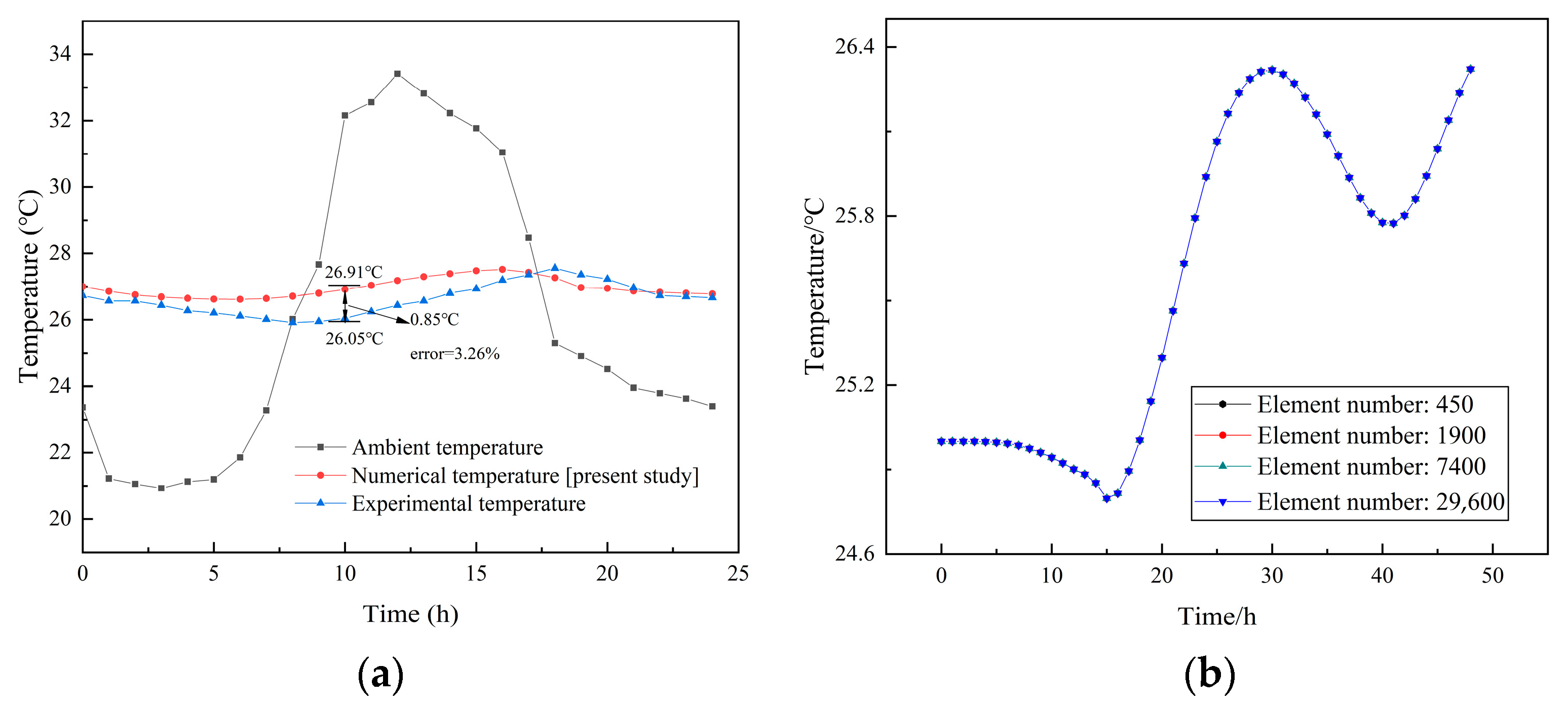
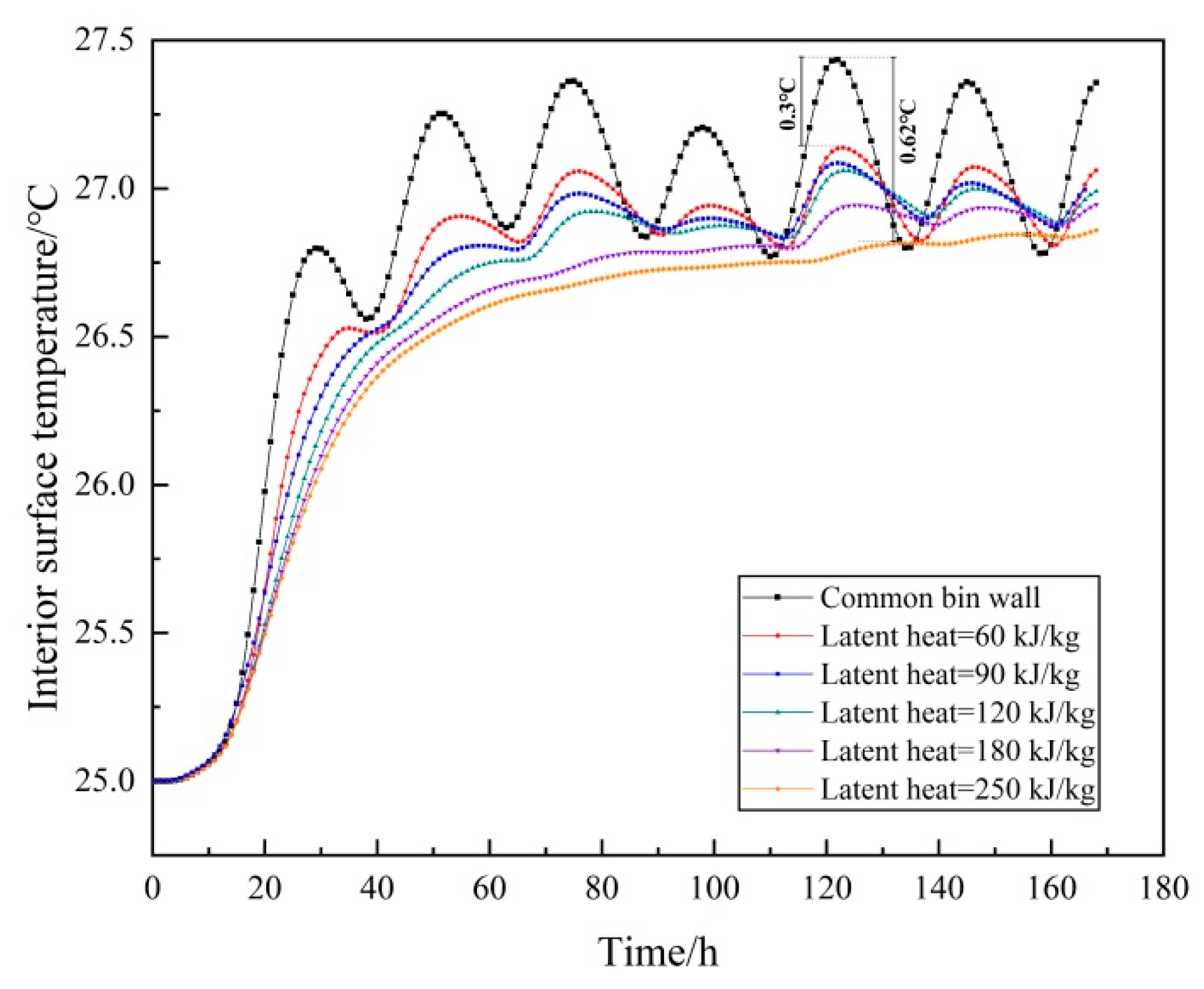

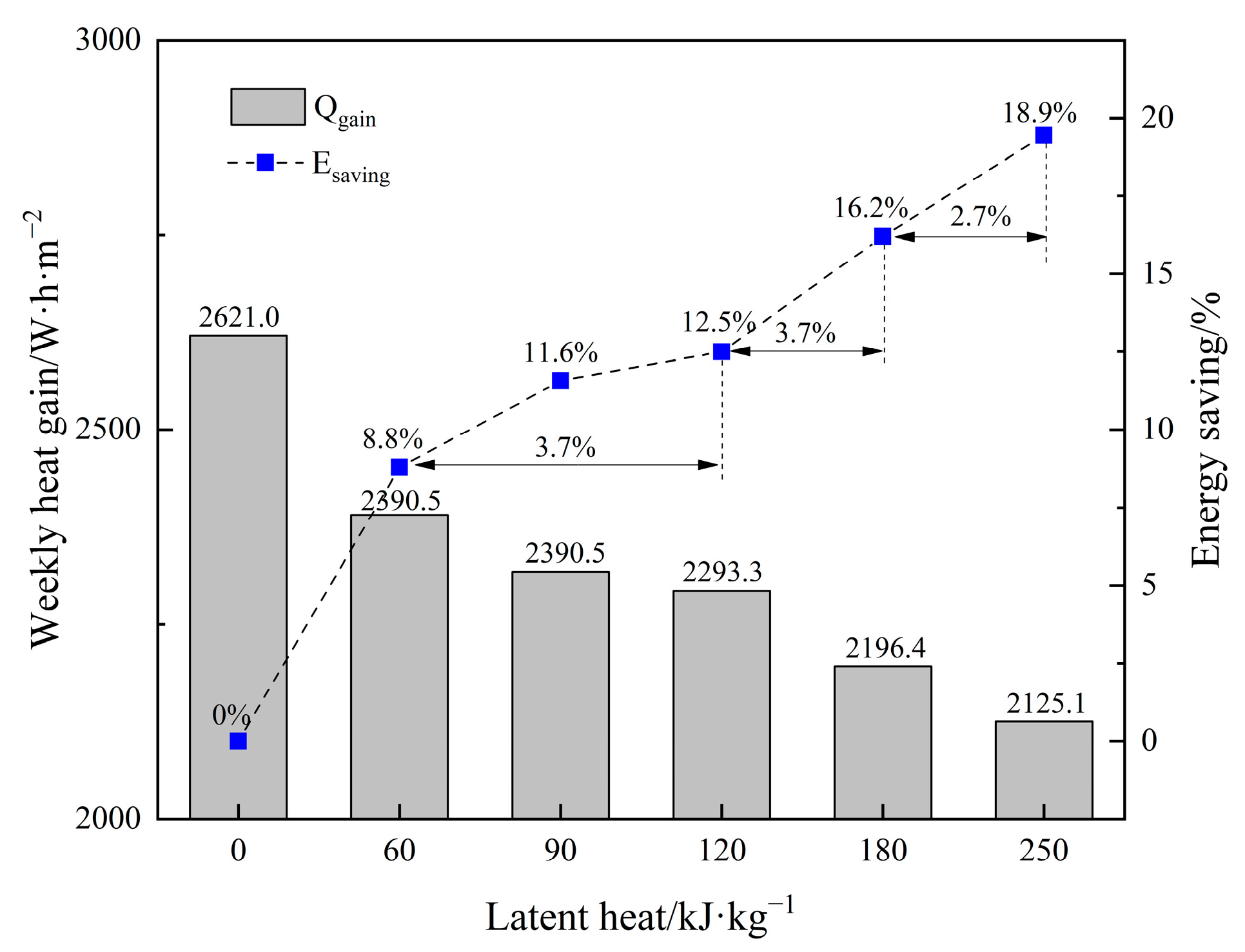
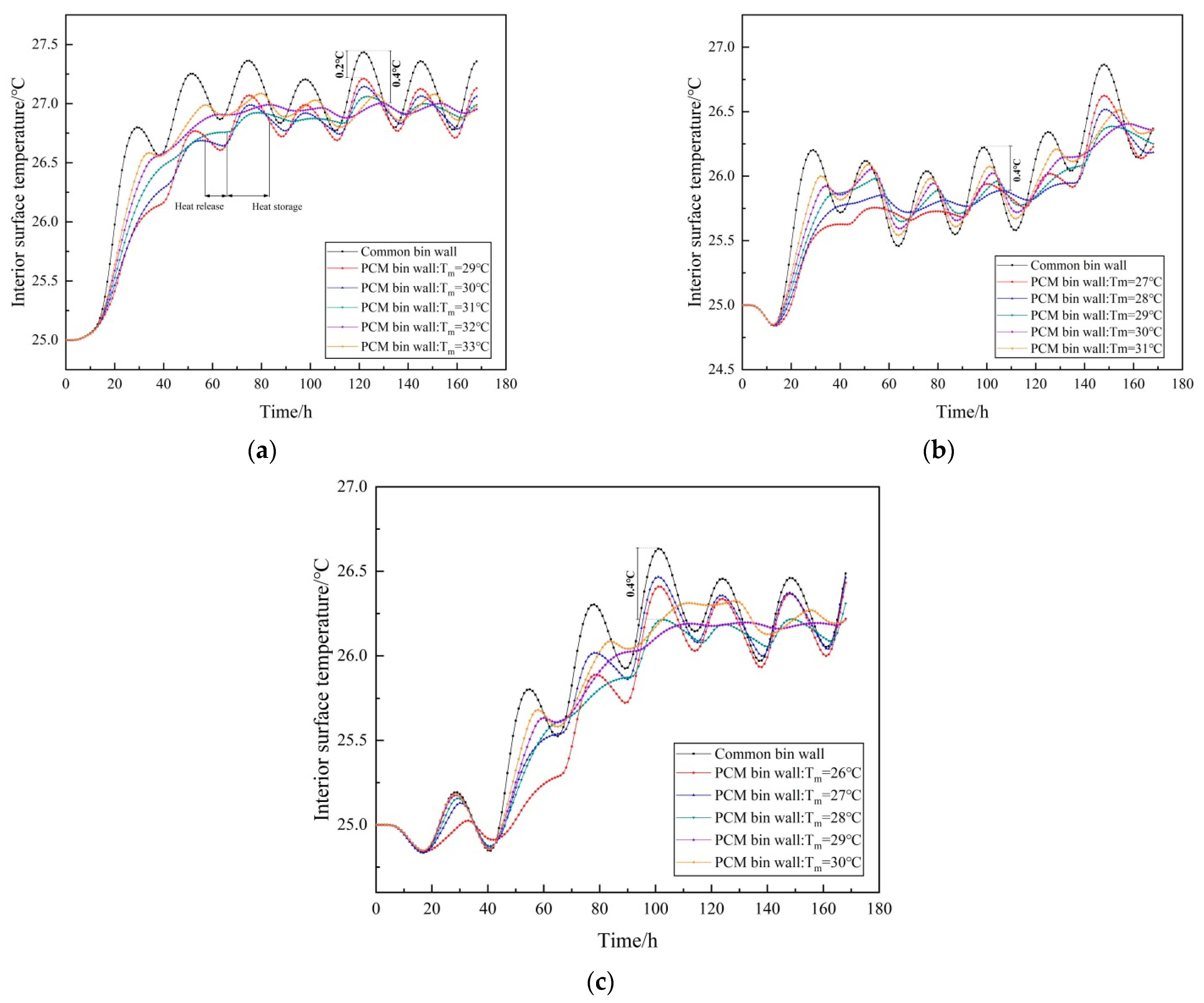
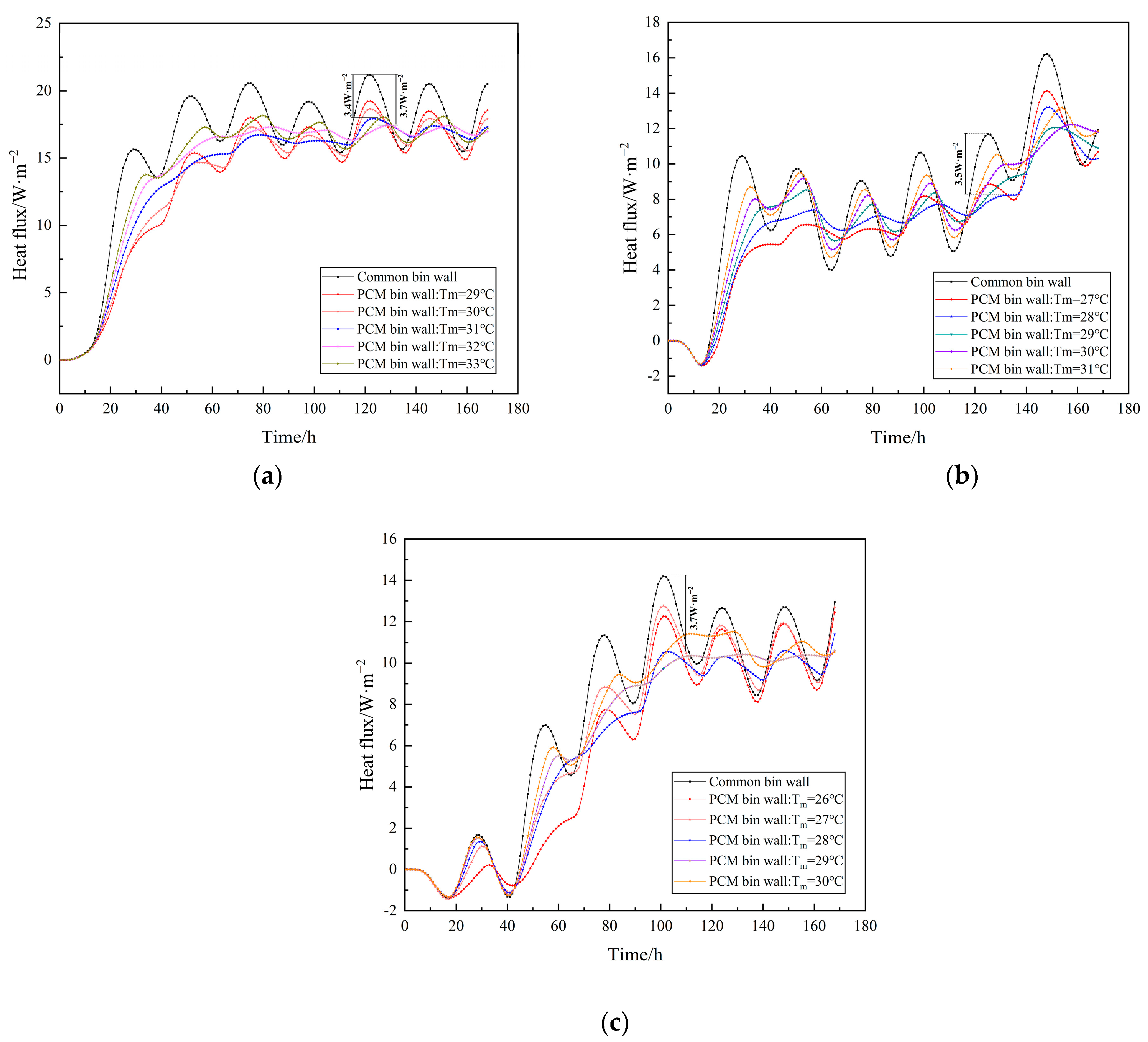
| Materials | Density (kg/m3) | Specific Heat (kJ/kg·K) | Thermal Conductivity (W/m2·K) | Latent Heat (kJ/kg) |
|---|---|---|---|---|
| Concrete | 2400 | 1.030 | 1.23 | 0 |
| PCM | 890 | 1.500 | 0.8 | 60–250 |
| City | Parameters | Common Bin Wall | PCM Bin Wall | ||||
|---|---|---|---|---|---|---|---|
| Phase Change Temperature of PCM (°C) | |||||||
| 29 | 30 | 31 | 32 | 33 | |||
| Guangzhou | Q (W·h·m−2) | 2621.0 | 2244.6 | 2242.2 | 2293.1 | 2372.8 | 2403.7 |
| ΔQ (W·h·m−2) | / | 376.5 | 378.8 | 327.4 | 248.3 | 217.3 | |
| (%) | / | 14.4 | 14.5 | 12.5 | 9.5 | 8.3 | |
| City | Parameters | Common Bin Wall | PCM Bin Wall | ||||
|---|---|---|---|---|---|---|---|
| Phase Change Temperature of PCM (°C) | |||||||
| 27 | 28 | 29 | 30 | 31 | |||
| Zhengzhou | Q (W·h·m−2) | 1324.3 | 1095.4 | 1128.0 | 1166.0 | 1209.2 | 1236.8 |
| ΔQ (W·h·m−2) | / | 228.9 | 196.2 | 158.2 | 115.1 | 87.5 | |
| (%) | / | 17.3 | 14.8 | 11.9 | 8.8 | 6.6 | |
| City | Parameters | Common Bin Wall | PCM Bin Wall | ||||
|---|---|---|---|---|---|---|---|
| Phase Change Temperature of PCM (°C) | |||||||
| 26 | 27 | 28 | 29 | 30 | |||
| Harbin | Q (W·h·m−2) | 1189.6 | 945.0 | 1056.8 | 981.5 | 1036.7 | 1099.7 |
| ΔQ (W·h·m−2) | / | 244.6 | 132.8 | 208.1 | 152.9 | 89.9 | |
| (%) | / | 20.6 | 11.6 | 17.5 | 12.9 | 7.6 | |
| PCM Thickness (mm) | Thermal Resistance (m2·K/W) | Regenerative Indicator (W·m−2·K) | Thermal Inertia Index | |
|---|---|---|---|---|
| Concrete bin wall | - | 0.3 | 10.66 | 3.21 |
| PCM bin wall | 40 | 0.32 | 39.97 | 15.63 |
| Grain Storage Regions | ΔQgain/W·h·m−2 | Qseason/kW·h | P/CNY |
|---|---|---|---|
| Guangzhou-Tm—31 °C | 327.4 | 2095.7 | 366.7 |
| Zhengzhou-Tm—28 °C | 196.2 | 1256.1 | 219.8 |
| Harbin-Tm—28 °C | 208.8 | 1337.1 | 234.0 |
Publisher’s Note: MDPI stays neutral with regard to jurisdictional claims in published maps and institutional affiliations. |
© 2022 by the authors. Licensee MDPI, Basel, Switzerland. This article is an open access article distributed under the terms and conditions of the Creative Commons Attribution (CC BY) license (https://creativecommons.org/licenses/by/4.0/).
Share and Cite
Wang, Y.; Zeng, C.; Hu, C. Thermal Performance and Energy Conservation Effect of Grain Bin Walls Incorporating PCM in Different Ecological Areas of China. Processes 2022, 10, 2360. https://doi.org/10.3390/pr10112360
Wang Y, Zeng C, Hu C. Thermal Performance and Energy Conservation Effect of Grain Bin Walls Incorporating PCM in Different Ecological Areas of China. Processes. 2022; 10(11):2360. https://doi.org/10.3390/pr10112360
Chicago/Turabian StyleWang, Yan, Changnv Zeng, and Chaoxin Hu. 2022. "Thermal Performance and Energy Conservation Effect of Grain Bin Walls Incorporating PCM in Different Ecological Areas of China" Processes 10, no. 11: 2360. https://doi.org/10.3390/pr10112360
APA StyleWang, Y., Zeng, C., & Hu, C. (2022). Thermal Performance and Energy Conservation Effect of Grain Bin Walls Incorporating PCM in Different Ecological Areas of China. Processes, 10(11), 2360. https://doi.org/10.3390/pr10112360









